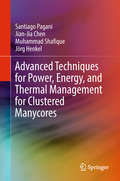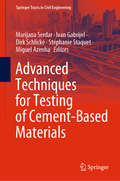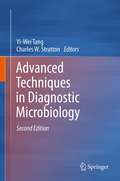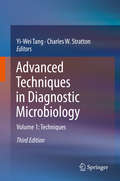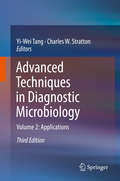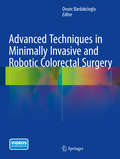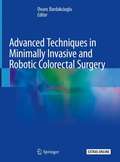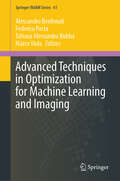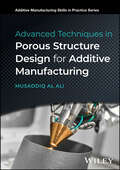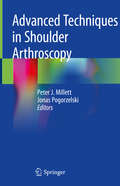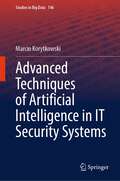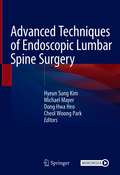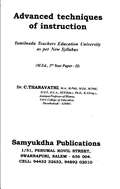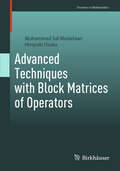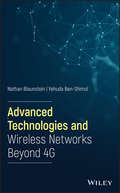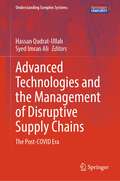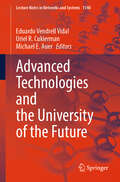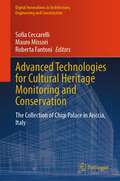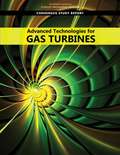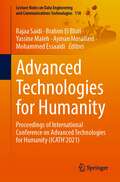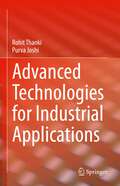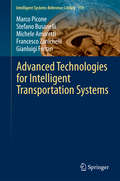- Table View
- List View
Advanced Techniques for Power, Energy, and Thermal Management for Clustered Manycores
by Jörg Henkel Muhammad Shafique Santiago Pagani Jian-Jia ChenThis book focuses on two of the most relevant problems related to power management on multicore and manycore systems. Specifically, one part of the book focuses on maximizing/optimizing computational performance under power or thermal constraints, while another part focuses on minimizing energy consumption under performance (or real-time) constraints.
Advanced Techniques for Testing of Cement-Based Materials (Springer Tracts in Civil Engineering)
by Miguel Azenha Marijana Serdar Ivan Gabrijel Dirk Schlicke Stéphanie StaquetThe book examines advanced, non-standardized techniques that have been developed for determining different properties of cement paste, mortar and concrete, and provides state-of-the-art information on methods for monitoring hydration-induced changes in cement-based materials (CBMs). These methods are often nondestructive and allow quasi-continuous monitoring covering the time span from placement of the material to formation of a fully hardened cement composite. The book also presents various applications of acoustic emission for characterizing fresh concrete, recent developments in ultrasonic methods for characterizing CBMs since placement, application of ambient response methods for measuring elastic modulus, methods for determining deformational characteristics of CBMs since setting and methods for in situ measurements of stresses in concrete elements during hardening.
Advanced Techniques in Diagnostic Microbiology
by Charles W. Stratton Yi-Wei TangIn the United States, hospitals annually report over 5 million cases of infectious-disease-related illnesses: clinical microbiology laboratories in these hospitals are engaged in detecting and identifying the pathogenic microorganisms in clinical specimens collected from these patients with suspected infections. Clearly, the timely and accurate detection/identification of these microbial pathogens is critical for patient treatment decisions and outcomes for millions of patients each year. Despite an appreciation that the outcome of an infectious-disease-related illness is directly related to the time required to detect and identify a microbial pathogen, clinical microbiology laboratories in the United States as well as worldwide have long been hampered by traditional culture-based assays, which may require prolonged incubation time for slowly growing microorganisms such as Mycobacterium tuberculosis. Moreover, traditional culture-based assays often require multiple steps with additional time needed for discernment of species and/or detection of antimicrobial resistance. Finally, these traditional, slow multistep culture-based assays are labor-intensive and required skilled clinical microbiologists at the bench. Over the past several decades, advanced molecular techniques in diagnostic microbiology quietly have been revolutionizing the practice of clinical microbiology in the hospital setting. Indeed, molecular diagnostic testing in general and nucleic-acid-based amplification methods in particular have been heralded as diagnostic tools for the new millennium. There is no question that the development of rapid molecular techniques for nucleic acid amplification/characterization combined with automation and user-friendly software has greatly broadened the diagnostic capabilities of the clinical microbiology laboratory. These technical advances in molecular microbiology over the first decade of the 21st Century have profoundly influenced the physical structure of clinical microbiology laboratories as well as their staffing patterns, workflow, and turnaround time. These molecular microbiology advances have also resulted in the need for a revised and updated second edition of Advanced Techniques in Diagnostic Microbiology. This second edition again provides an updated and comprehensive description of the ongoing evolution of molecular methods for the diagnosis of infectious diseases. In addition, many new chapters have been added, including a chapter on the clinical interpretation and relevance of advanced technique results. The second edition, like the first edition, includes both a "techniques" section describing the latest molecular techniques and an "applications" section describing how these advanced molecular techniques are being used in the clinical setting. Finally, the second edition, like the first edition, utilizes a diverse team of authors who have compiled chapters that provide the reader with comprehensive and useable information on advanced molecular microbiology techniques.
Advanced Techniques in Diagnostic Microbiology: Volume 1: Techniques
by Charles W. Stratton Yi-Wei TangIn recent years, advanced molecular techniques in diagnostic microbiology have been revolutionizing the practice of clinical microbiology in the hospital setting. Molecular diagnostic testing in general and nucleic acid-based amplification methods in particular have been heralded as diagnostic tools for the new millennium. This third edition covers not only the most recent updates and advances, but details newly invented omic techniques, such as next generation sequencing. It is divided into two distinct volumes, with Volume 1 describing the techniques, and Volume 2 addressing their applications in the field. In addition, both volumes focus more so on the clinical relevance of the test results generated by these techniques than previous editions.
Advanced Techniques in Diagnostic Microbiology: Volume 2: Applications
by Charles W. Stratton Yi-Wei TangIn recent years, advanced molecular techniques in diagnostic microbiology have been revolutionizing the practice of clinical microbiology in the hospital setting. Molecular diagnostic testing in general and nucleic acid-based amplification methods in particular have been heralded as diagnostic tools for the new millennium. This third edition covers not only the most recent updates and advances, but details newly invented omic techniques, such as next generation sequencing. It is divided into two distinct volumes, with Volume 1 describing the techniques, and Volume 2 addressing their applications in the field. In addition, both volumes focus more so on the clinical relevance of the test results generated by these techniques than previous editions.
Advanced Techniques in Limb Reconstruction Surgery
by Mehmet Kocaoğlu Hiroyuki Tsuchiya Levent EralpAs a result of recent advances in surgical techniques and implant technology it is now possible to perform limb reconstruction in patients with a range of congenital, posttraumatic, and postinfection pathologies. This book is a clear, practical guide to the state-of-the-art surgical procedures employed in limb reconstruction for diverse conditions. It includes precise descriptions of the techniques themselves, accompanied by numerous helpful drawings and photographs. Pearls and pitfalls are highlighted, and thorough advice is also provided on indications, preoperative planning, and postoperative follow-up. The editors have carefully selected the contributors based on their expertise, and many of the authors were themselves responsible for developing the techniques that they describe.
Advanced Techniques in Minimally Invasive and Robotic Colorectal Surgery
by Ovunc BardakciogluLaparoscopic colectomy has been introduced in the early 90ies as a new technique with proven improvement in short and long term outcome. Despite significant patient benefits the overall adoption rate remains low. On the other hand significant more advanced techniques such as single incision laparoscopy, robotics and transanal access surgery have been introduced in the last several years and are rapidly evolving. Therefore a significant gap between the practicing community surgeon and innovator seems to exist. Advanced Techniques in Minimally Invasive and Robotic Colorectal Surgery bridges that gap and provides a foundation summarizing and organizing all classic and new techniques in minimally invasive colorectal surgery available in literature and from masters within the field. It provides tips and tricks that allow the user to move up the learning curve, manage difficult scenarios, overcome challenges, increase the utilization of minimal invasive techniques and decrease the conversion to open surgery. By enhancing the surgical tool box the surgeon will be able to progress from the novice to the master. Rather than describing operative procedures which may be very biased by an individual author, the guide provides alternative building blocks of various difficulty for different procedures which can be then tailored to the patient and surgeon`s own comfort level and experience. Advanced Techniques in Minimally Invasive and Robotic Colorectal Surgery will serve as a inspirational guide for the innovator of the future. It will allow surgeons of all levels to better adapt to inevitable changes in future techniques and will be of great value to general surgeons, colon and rectal surgeons, minimally invasive surgeons as well as residents and fellows.
Advanced Techniques in Minimally Invasive and Robotic Colorectal Surgery
by Ovunc BardakciogluThe first edition laid out the foundation with laparoscopic and robotic surgery utilizing the Da Vinci SI platform. Since then, many new advances in equipment and surgical techniques are becoming more popular. This second edition expands upon laparoscopic and endoscopic techniques and robotic surgery with the use of the new Da Vinci XI platform.This book bridges the gap between the practicing community of surgeons and the surgical innovators and provides a foundation for all classic and new techniques in minimally invasive colorectal surgery. By enhancing the surgical toolbox, the surgeon is able to progress from the novice to the master. Rather than describing the entire operative procedure by an individual author, this book compares operative steps of various technical difficulties throughout different chapters, thereby allowing the surgeon to tailor surgery to patient and surgeon`s own comfort level and experience. Chapters are written by a myriad of renowned experts in the field and discuss the major advances in advanced laparoscopic and endoscopic, robotic, and transanal minimally invasive surgical techniques. Great emphasis is placed on transanal total mesorectal excision (TaTME), which is dramatically changing the surgical approach to rectal resections. The second edition of Advanced Techniques in Minimally Invasive and Robotic Colorectal Surgery serves as a valuable resource to general surgeons, colon and rectal surgeons, minimally invasive surgeons, as well as residents and fellows.
Advanced Techniques in Optimization for Machine Learning and Imaging (Springer INdAM Series #61)
by Marco Viola Alessandro Benfenati Federica Porta Tatiana Alessandra BubbaIn recent years, non-linear optimization has had a crucial role in the development of modern techniques at the interface of machine learning and imaging. The present book is a collection of recent contributions in the field of optimization, either revisiting consolidated ideas to provide formal theoretical guarantees or providing comparative numerical studies for challenging inverse problems in imaging. The work of these papers originated in the INdAM Workshop “Advanced Techniques in Optimization for Machine learning and Imaging” held in Roma, Italy, on June 20-24, 2022. The covered topics include non-smooth optimisation techniques for model-driven variational regularization, fixed-point continuation algorithms and their theoretical analysis for selection strategies of the regularization parameter for linear inverse problems in imaging, different perspectives on Support Vector Machines trained via Majorization-Minimization methods, generalization of Bayesian statistical frameworks to imaging problems, and creation of benchmark datasets for testing new methods and algorithms.
Advanced Techniques in Porous Structure Design for Additive Manufacturing (Additive Manufacturing Skills in Practice.)
by Musaddiq Al AliConcise, practical guide presenting skills to integrate porous structure design with additive manufacturing requirements Part of Wiley’s Additive Manufacturing Skills in Practice series and written with the industry practitioner in mind, Advanced Techniques in Porous Structure Design for Additive Manufacturing addresses the growing integration of porous structures and additive manufacturing, essential for applications in the biomedical, aerospace, and automotive fields in which porous structures are crucial due to their ability to deliver top-notch performance alongside lightweight characteristics. This book covers all areas of the subject and concludes with a series of specialized chapters devoted to simulation software, case studies, and future trends and emerging technologies. Each chapter features a design problem that presents an open-ended scenario to prompt readers to think through the real-world applications of the concepts and theories discussed and connect them to their own job roles. Topics discussed in Advanced Techniques in Porous Structure Design for Additive Manufacturing include: Fundamentals of additive manufacturing, covering processes, materials, and design considerationsMathematical modeling, covering optimization techniques and the finite element methodMultiscale topology optimization, shape optimization methods, and post-processing techniquesSoftware utilization in porous structure design, with information on how to program simulationsPorous structures in soft robotics, porous heat sinks, porous plates, and porous mechanical support structures With a blend of theoretical understanding and hands-on expertise in an emerging domain, Advanced Techniques in Porous Structure Design for Additive Manufacturing is an essential reference for industry professionals, researchers, and postgraduate students in universities, particularly those specializing in mechanical design and additive manufacturing.
Advanced Techniques in Shoulder Arthroscopy
by Peter J. Millett Jonas PogorzelskiThis book is written for the benefit of all surgeons who have an interest in arthroscopic shoulder surgery. It is a compendium of different aspects of shoulder surgery that have been learned over the last 25 years. While there has been a rapid progression of shoulder surgery over the last two decades, particularly with the advancement of operative arthroscopic surgery, certain principles remain. The purpose of this book is not to be an exhaustive detailed account of the various historical aspects of arthroscopic shoulder surgery, but rather to act as an up-to-date, instructional handbook that outlines these principles. The book also helps the practicing shoulder surgeon become familiar some of the latest techniques in arthroscopic shoulder surgery, demonstrating proven approaches and outlining key aspects of common and uncommon procedures. Each chapter starts with the indications for the procedure, moves towards the appropriate evaluation and diagnostic work up, and culminates in specific technical explanation of the surgical procedure itself.Advanced Techniques in Shoulder Arthroscopy is a valuable resource for those who are new to arthroscopic shoulder surgery and for those who are skilled and experienced in operative arthroscopy. It is meant to provide a foundation for basic and advanced arthroscopic techniques that helps surgeons improve their craft and treat their patients better.
Advanced Techniques of Artificial Intelligence in IT Security Systems (Studies in Big Data #146)
by Marcin KorytkowskiThe book explores how modern technologies, including artificial intelligence and neural networks, are being used to enhance cybersecurity. In today's world, the development of the Internet is nothing short of transformative, affecting every aspect of our lives. Ensuring the safety of its users is a paramount concern, and it requires a diverse set of disciplines to address. Researchers from various fields, including IT, mathematics, psychology, and medicine, are collectively working to tackle this interdisciplinary challenge. The significance of this issue has been magnified by the COVID-19 pandemic, which forced many aspects of our lives into the digital realm, from online payments to remote work and education. This shift brought new security challenges, with data privacy and system integrity taking center stage. It delves into the intricacies of Big Data by having to analyze an immense volume of network traffic data that can only be effectively analyzed with specialized tools. Real-time threat detection is critical, and the book sheds light on cutting-edge approaches to achieving this goal. The content of the book covers a broad spectrum of topics related to IT system security, from user and system profiling to preventing data leaks and defending against phishing attacks. Additionally, innovative concepts such as “glial networks” are introduced, offering new ways to interpret knowledge stored in convolutional networks. These solutions are not limited to security alone; they have applications across various domains. The book highlights the advantages of these cutting-edge approaches over existing methods, demonstrating their relevance to large corporations, public institutions, schools, small businesses, and households. In a world where security threats are constantly evolving, this book is a valuable resource for understanding the dynamic landscape of network security and the role of artificial intelligence in safeguarding our digital ecosystems.
Advanced Techniques of Endoscopic Lumbar Spine Surgery
by Michael Mayer Hyeun Sung Kim Dong Hwa Heo Cheol Woong ParkThis book is a superbly illustrated guide to the latest endoscopic approaches employed in surgery to the lumbar spine. In the past, spinal endoscopic surgeries have been performed mainly in the treatment of lumbar disc herniation, but indications have now expanded owing to breakthroughs in surgical methods and instruments. Furthermore, in addition to the traditional percutaneous transforaminal approach, various other approaches are now feasible, including the posterior, paraspinal, transpedicular, and contralateral. This book describes and illustrates the full array of approaches in indications including lumbar central stenosis, lumbar foraminal stenosis, and lumbar disc herniation. Detailed guidance is also provided on endoscopic lumbar interbody fusion, covering the oblique, uniportal, and biportal approaches. Supplementary surgical videos further facilitate understanding and execution of the described procedures. Written by expert spinal endoscopy surgeons with extensive practical experience and a record of academic achievement, the book will be an ideal aid for spine surgeons at all levels of experience.
Advanced Techniques of Hypnosis: A Professional Hypnotist Reveals New Procedures for Inducing Both Deep and Self-Hypnosis
by Melvin PowersThere have been many books written on the therapeutic value of hypnosis. Numerous volumes have dealt with its history, and many more have been concerned with its various phenomena. There has, however, been comparatively little written about the actual technique of inducing the hypnotic state. Since this phase of hypnosis has been so woefully neglected, we have not had the rapid technical development our vital science so rightfully deserves. This volume is designed to remedy that lack.This book is dedicated to those who aspire to a fuller understanding of hypnotic procedures. It is my purpose to show you, the reader, how to develop any individual into a receptive, hypnotic subject, and to give you the necessary understanding and knowledge required to achieve this end. You will also be instructed in the use of my original techniques, which have proven to be so wonderfully effective in my long experience as a professional hypnotist. A careful reading of the book will not only be rewarding because of the wealth of information contained in it, but will also assure the reader maximum professional efficiency in the exciting, and fascinating practice of professional hypnosis.
Advanced Techniques of Instruction
by Dr C ThanavathiThis Advanced Techniques of Instruction book description and analysis of the subject is the Indian context. It covers the syllabus of Tamil Nadu Teachers Education University on this subject in simple and lucid language drawing examples from our society and Indian technological system.
Advanced Techniques with Block Matrices of Operators (Frontiers in Mathematics)
by Mohammad Sal Moslehian Hiroyuki OsakaThis book introduces several powerful techniques and fundamental ideas involving block matrices of operators, as well as matrices with elements in a C*-algebra. These techniques allow for the solution of problems that may be difficult to treat. Specifically, 2×2 operator matrices yield significant mathematical inequalities in various fields of operator theory and matrix analysis. The authors employ block matrices to simplify complicated problems. Operator matrices have garnered attention for their applications in quantum information and computing theories. Each chapter concludes with a diverse set of exercises and problems for readers, along with references to relevant literature. Some problems pose open questions, while others challenge readers and provide suggestions for future research. This book is suitable for an advanced undergraduate or graduate course and can be used in the classroom. It also serves as a valuable resource for researchers and students in mathematics and physics who have a basic understanding of linear algebra, functional analysis, and operator theory.
Advanced Technologies and Wireless Networks Beyond 4G
by Nathan Blaunstein Yehuda Ben-ShimolA guide to the physical and mathematical-statistical approaches to personal and mobile wireless communication networks Wireless Networks Technologies offers an authoritative account of several current and modern wireless networks and the corresponding novel technologies and techniques. The text explores the main aspects of the "physical layer" of the technology. The authors—noted experts on the topic—examine the well-known networks (from 2-G to 3-G) in a historical perspective. They also illuminate the "physical layer" of networks while presenting polarization diversity analysis and positioning of any subscriber located in areas of service both for land-to-land and land-to-atmosphere communication links. The book includes clear descriptions of planning techniques for different integrated femto/pico/micro/macrocell deployments. The authors also examine new technologies of time and frequency dispersy and multiple-input and multiple-output (MIMO) modern network design in space and time domains. In addition, the text contains a discussion of a MIMO network based on multi-beam adaptive antennas. This important book: Provides an examination of current and modern wireless networks Describes various techniques of signal data capacity and spectral efficiency based on the universal stochastic approach Explains how usage of MIMO systems with adaptive multi-beam antennas increase the grade of service and quality of service of modern networks beyond 4-G Provides comparative analysis of depolarization effects and the corresponding path loss factor for rural, mixed residential, suburban, and urban land areas Written for students and instructors as well as designers and engineers of wireless communications systems, Wireless Networks Technologies offers a combination of physical and mathematical-statistical approaches to predict operational parameters of land-to-land and land-to-atmosphere personal and mobile wireless communication networks.
Advanced Technologies and the Management of Disruptive Supply Chains: The Post-COVID Era (Understanding Complex Systems)
by Hassan Qudrat-Ullah Syed Imran AliThe book explores cost-effective and efficient supply chain management to achieve resilience in the post-COVID environment. Qualitative, quantitative, case studies, and systematic literature reviews are made in the book. The book follows a didactic approach through which it informs global researchers and practitioners to deal with the most significant insights on future supply chains with a more in-depth analysis of post-COVID opportunities and challenges. In particular, this book provides an in-depth assessment of disruptive supply chain management in certain industrial contexts and explores various Industry 4.0 and Industry 5.0 technologies to achieve resilience. The book is used as a supplemental textbook for study within university level programs, at late undergraduate and graduate levels, in faculties of business and management, engineering systems, information systems, education, and computing.
Advanced Technologies and the University of the Future (Lecture Notes in Networks and Systems #1140)
by Michael E. Auer Uriel R. Cukierman Eduardo Vendrell VidalThis book offers a comprehensive framework, compiling solutions and evidence from various sections that illustrate how technology can shape both the learning experience and the organizational structure of higher education institutions. The integration of technology in higher education, including advancements such as AI, large language models (LLMs), the metaverse, and gamification techniques, has sparked significant interest among academics and researchers. This technological evolution is not only influencing research and teaching but is also transforming universities at every level. The book envisions the university of the future, providing ideas to foster collaboration and enhance research. The full text is structured into 32 chapters organized into five sections, each exploring different technologies that can or have been applied in higher education. Extended Reality (XR): It includes the reality-virtuality continuum, which includes augmented reality (AR), mixed reality (MR), virtual reality (VR), haptic devices, and more recently the metaverse. Artificial Intelligence (AI): It includes everything related to the automated analysis of large volumes of information and its application in the form of learning analytics, adaptive learning and automatic learning (machine learning) and also chatbots, which have emerged into mainstream conversation due to the appearance of ChatGPT. Digital Transformation (DX): It is understood as the possibility of taking advantage of the available technologies to change the programs and the organization of teaching and learning. This subject also includes themes such as information security and privacy and open badges. Gamification: It refers to the incorporation of serious game elements, like point and reward systems, to tasks as incentives for people to participate. Emerging Technologies in Higher Education: It encompasses a comprehensive spectrum spanning research endeavors, application development, first-hand accounts, and detailed descriptions of educational tools
Advanced Technologies for Cultural Heritage Monitoring and Conservation: The Collection of Chigi Palace in Ariccia, Italy (Digital Innovations in Architecture, Engineering and Construction)
by Sofia Ceccarelli Mauro Missori Roberta FantoniThis book provides the results of an extensive scientific measurements campaign using advanced technologies and innovative non-invasive approaches carried out for the first time in such large numbers inside one of the most important baroque residences in Italy, the Chigi Palace in Ariccia, near Rome (Italy), with the aims of monitoring, characterizing and documenting several kinds of heritage items with different conservative and artistic issues. The analyses involved several research groups from regional universities (Sapienza, Tor Vergata, Roma 3) and research institutions (ENEA, INFN, CNR) and they were performed within the ADAMO project, which was addressed to technologies of analysis, diagnostics and monitoring for the preservation and restoration of Cultural Heritage. The project was proposed by the Centre of Excellence at the Technological District for Cultural Heritage (DTC) financed by the Lazio Region. At the Chigi Palace, important collections of paintings, documents, statues and wall decorations are preserved, dating back from the 16th up to the 18th centuries. The purpose of this book is twofold: it provides an overview of methodologies and technologies currently available in the field of heritage science, through the presentation of their in situ applications for the study of different artworks and materials; furthermore, it shows how the non-invasive analyses and the integration of diagnostic results are useful and sometimes crucial, for the overall understanding of heritage items, their conservation status, and for their correct conservation. This book is addressed at a large audience with both humanistic and scientific backgrounds, focusing the reader's attention on the information gained from multidisciplinary studies, also allowing a curious look at scientific methodologies applied to an art-historical context.
Advanced Technologies for Future Transmission Grids (Power Systems)
by Gianluigi MigliavaccaThe re-engineering of power transmission systems is crucial to meeting the objectives of such regulators as the European Union. In addition to its market, organisational and regulatory aspects, this re-engineering will also involve technical issues dealing with the progressive integration of innovative transmission technologies in the daily operation of transmission system operators. In this context, Advanced Technologies for Future Transmission Grids provides an overview of the most promising technologies, likely to be of help to planners of transmission grids in responding to the challenges of the future: security of supply; integration of renewable generation; and creation of integrated energy markets (using the European case as an example). These issues have increased importance because of administrative complication and the fragmentation of public opinion expressed on the build up of new infrastructure. For each technology discussed, the focus is on the technical-economic perspective rather than on purely technological points of view. A transmission-system-operator-targeted Technology Roadmap is presented for the integration of promising innovative power transmission technologies within power systems of the mid-long term. Although the primary focus of this text is in the sphere of the European energy market, the lessons learned can be generalized to the energy markets of other regions.
Advanced Technologies for Gas Turbines
by Engineering Medicine National Academies of SciencesLeadership in gas turbine technologies is of continuing importance as the value of gas turbine production is projected to grow substantially by 2030 and beyond. Power generation, aviation, and the oil and gas industries rely on advanced technologies for gas turbines. Market trends including world demographics, energy security and resilience, decarbonization, and customer profiles are rapidly changing and influencing the future of these industries and gas turbine technologies. Technology trends that define the technological environment in which gas turbine research and development will take place are also changing - including inexpensive, large scale computational capabilities, highly autonomous systems, additive manufacturing, and cybersecurity. It is important to evaluate how these changes influence the gas turbine industry and how to manage these changes moving forward. Advanced Technologies for Gas Turbines identifies high-priority opportunities for improving and creating advanced technologies that can be introduced into the design and manufacture of gas turbines to enhance their performance. The goals of this report are to assess the 2030 gas turbine global landscape via analysis of global leadership, market trends, and technology trends that impact gas turbine applications, develop a prioritization process, define high-priority research goals, identify high-priority research areas and topics to achieve the specified goals, and direct future research. Findings and recommendations from this report are important in guiding research within the gas turbine industry and advancing electrical power generation, commercial and military aviation, and oil and gas production.
Advanced Technologies for Humanity: Proceedings of International Conference on Advanced Technologies for Humanity (ICATH'2021) (Lecture Notes on Data Engineering and Communications Technologies #110)
by Mohammed Essaaidi Yassine Maleh Rajaa Saidi Brahim El Bhiri Ayman MosallamThis book gathers the proceedings of the International Conference on Advanced Technologies for Humanity (ICATH’2021), held on November 26-27, 2021, in INSEA, Rabat, Morocco. ICATH’2021 was jointly co-organized by the National Institute of Statistics and Applied Economics (INSEA) in collaboration with the Moroccan School of Engineering Sciences (EMSI), the Hassan II Institute of Agronomy and Veterinary Medicine (IAV-Hassan II), the National Institute of Posts and Telecommunications (INPT), the National School of Mineral Industry (ENSMR), the Faculty of Sciences of Rabat (UM5-FSR), the National School of Applied Sciences of Kenitra (ENSAK) and the Future University in Egypt (FUE).ICATH’2021 was devoted to practical models and industrial applications related to advanced technologies for Humanity. It was considered as a meeting point for researchers and practitioners to enable the implementation of advanced information technologies into various industries. This book is helpful for PhD students as well as researchers.The 48 full papers were carefully reviewed and selected from 105 submissions. The papers presented in the volume are organized in topical sections on synergies between (i) smart and sustainable cities, (ii) communication systems, signal and image processing for humanity, (iii) cybersecurity, database and language processing for human applications, (iV) renewable and sustainable energies, (V) civil engineering and structures for sustainable constructions, (Vi) materials and smart buildings and (Vii) Industry 4.0 for smart factories.All contributions were subject to a double-blind review. The review process was highly competitive. We had to review 105 submissions from 12 countries. A team of over 100 program committee members and reviewers did this terrific job. Our special thanks go to all of them.
Advanced Technologies for Industrial Applications
by Rohit Thanki Purva JoshiThis book provides information on advanced communication technology used in Industry 4.0 and 5.0. The book covers a variety of technologies such as signal processing, system designing, computer vision, and artificial intelligence and explains their benefits, usage, and market values in Industry 4.0 and 5.0. The authors present technological tools for industrial applications and give examples of their usage of system design, modeling, artificial intelligence, internet of things and robotics. This book covers the impact of these technologies in various industrial applications and provides future technological tools that will be helpful in future planning and development. The book is pertinent to researchers, academics, professionals, planners, and student’s interest in Industry 5.0.
Advanced Technologies for Intelligent Transportation Systems (Intelligent Systems Reference Library #139)
by Gianluigi Ferrari Marco Picone Stefano Busanelli Michele Amoretti Francesco ZanichelliThis book focuses on emerging technologies in the field of Intelligent Transportation Systems (ITSs) namely efficient information dissemination between vehicles, infrastructures, pedestrians and public transportation systems. It covers the state-of-the-art of Vehicular Ad-hoc Networks (VANETs), with centralized and decentralized (Peer-to-Peer) communication architectures, considering several application scenarios. With a detailed treatment of emerging communication paradigms, including cross networking and distributed algorithms. Unlike most of the existing books, this book presents a multi-layer overview of information dissemination systems, from lower layers (MAC) to high layers (applications). All those aspects are investigated considering the use of mobile devices, such as smartphones/tablets and embedded systems, i. e. technologies that during last years completely changed the current market, the user expectations, and communication networks. The presented networking paradigms are supported and validated by means of extensive simulative analysis and real field deployments in different application scenarios. This book represents a reference for professional technologist, postgraduates and researchers in the area of Intelligent Transportation Systems (ITSs), wireless communication and distributed systems.
